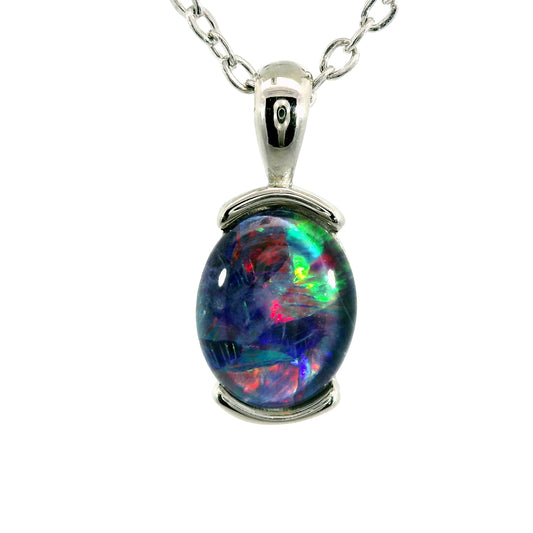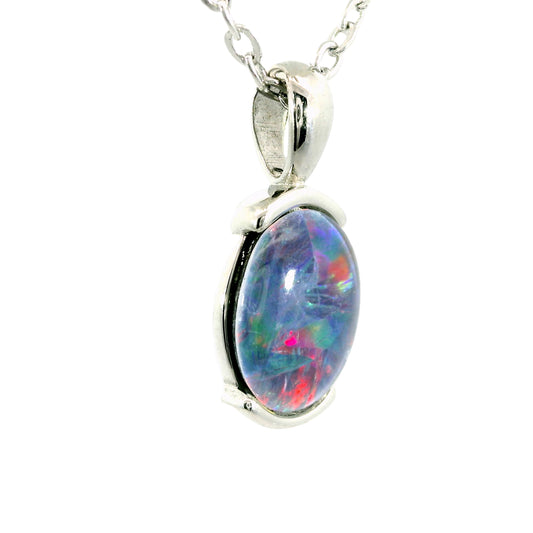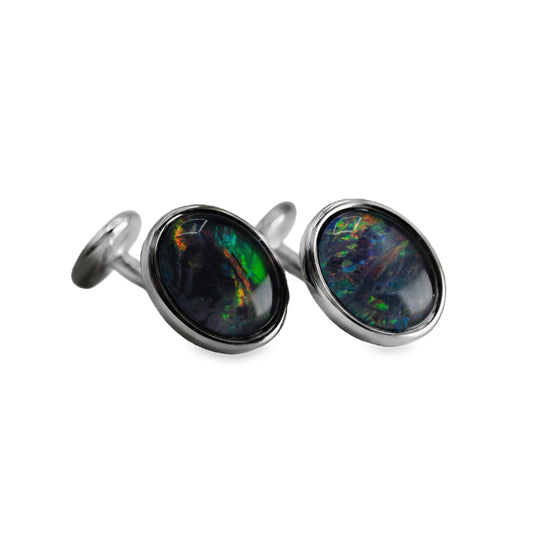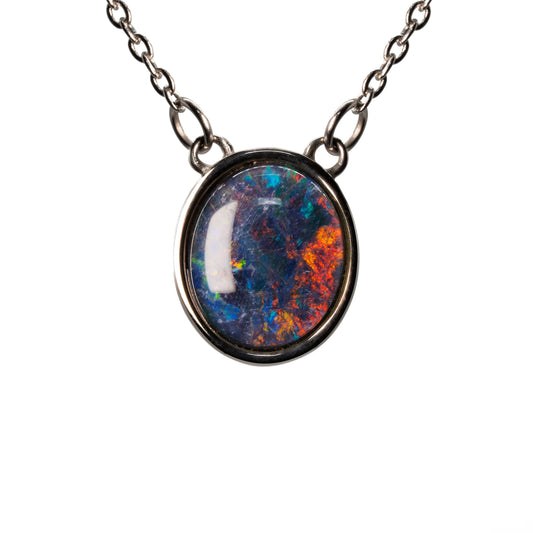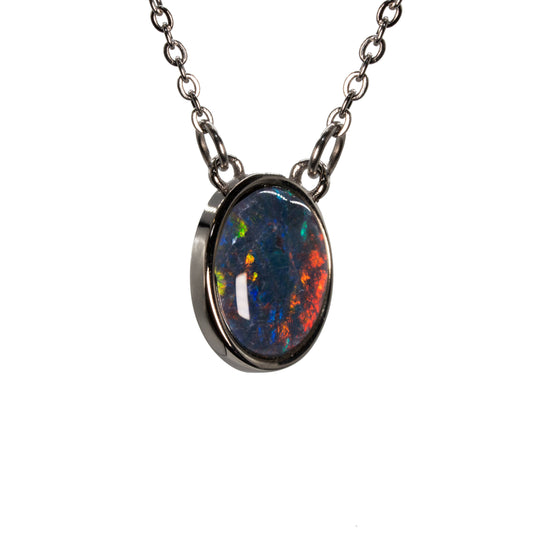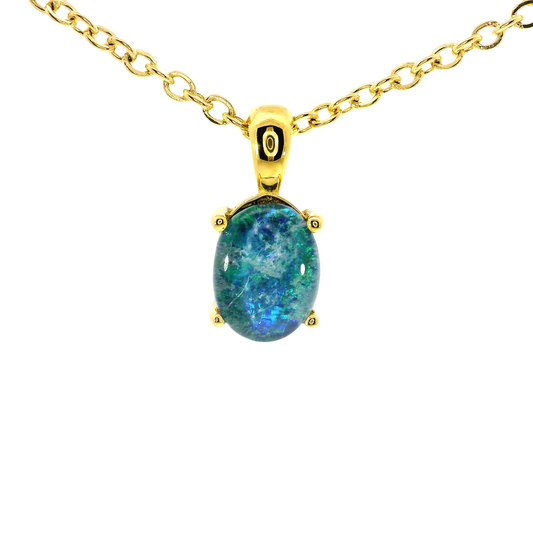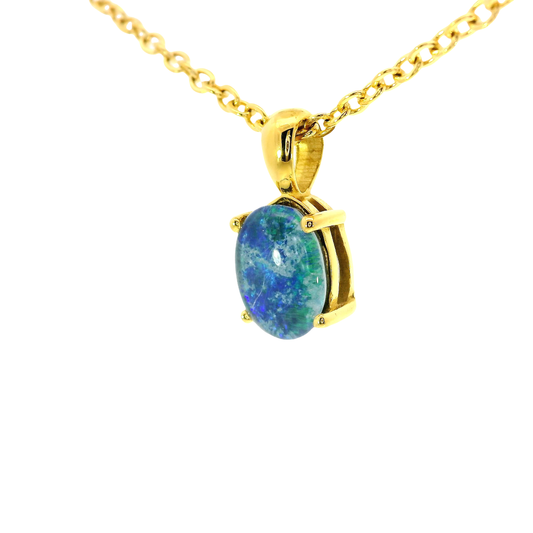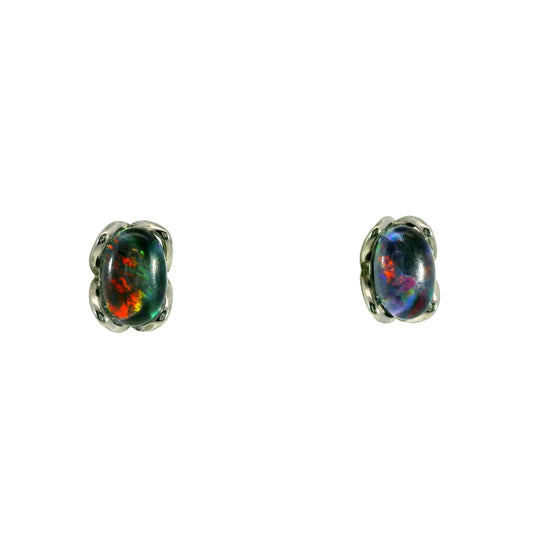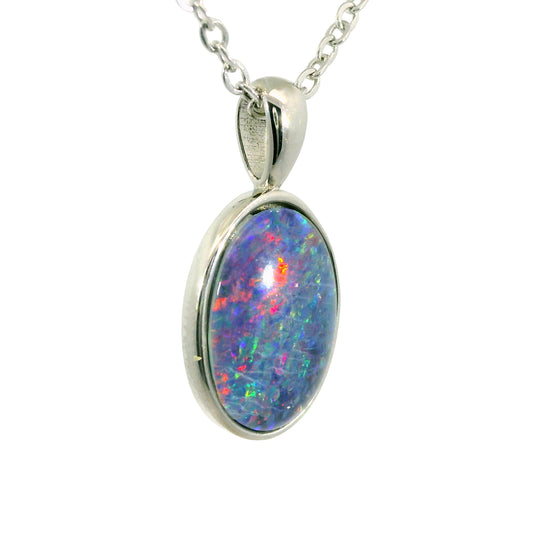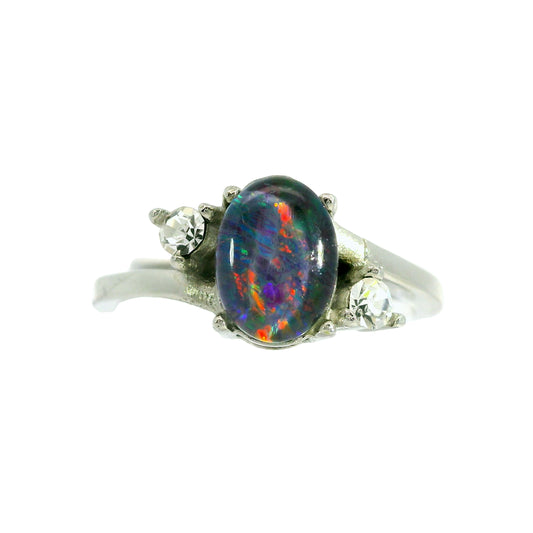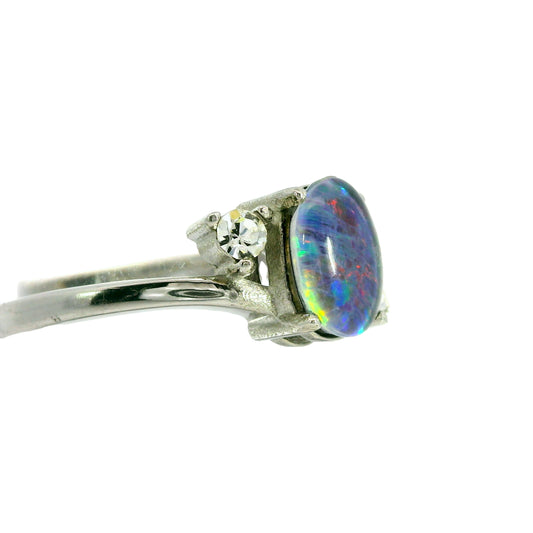Seeing Double: All About Doublet and Triplet Opals
Opals that have been formed into doublets or triplets, despite being a prominent practice for centuries, have been often overlooked by jewellers. This has lead to a distinct misunderstanding regarding surrounding these forms of opal jewellery, irreversibly tarnishing the otherwise-helpful jewellery technique.
practice for centuries, have been often overlooked by jewellers. This has lead to a distinct misunderstanding regarding surrounding these forms of opal jewellery, irreversibly tarnishing the otherwise-helpful jewellery technique.
What Are Opal Doublets and Triplets?
 Not everyone can afford tens of thousands of dollars for a pendant or ring. By taking a ‘slice’ of an Opal and laying this against a background of a darker opal (usually boulder opal or black opal) 'potch' (Opal without colour) we can provide a completely natural piece of Opal in all of its splendour and beauty and make it affordable! The facts are as follows: opal triplets are genuine, but not everyone who sells them may be. The issue with these practices is not the opal itself, but jewellers who may not advertise that the opal is a doublet or triplet. The reason this is so important to see is that,
Not everyone can afford tens of thousands of dollars for a pendant or ring. By taking a ‘slice’ of an Opal and laying this against a background of a darker opal (usually boulder opal or black opal) 'potch' (Opal without colour) we can provide a completely natural piece of Opal in all of its splendour and beauty and make it affordable! The facts are as follows: opal triplets are genuine, but not everyone who sells them may be. The issue with these practices is not the opal itself, but jewellers who may not advertise that the opal is a doublet or triplet. The reason this is so important to see is that,  without proper knowledge, customers may buy an opal under false pretences, thinking that their purchase is a solid opal when it is actually a triplet or synthetic piece (fake opal). Fundamentally, this has negative impacts on the fostering of trust between customers and wholesalers, which is something that can not easily be repaired.
without proper knowledge, customers may buy an opal under false pretences, thinking that their purchase is a solid opal when it is actually a triplet or synthetic piece (fake opal). Fundamentally, this has negative impacts on the fostering of trust between customers and wholesalers, which is something that can not easily be repaired.
Opal triplets were discovered in the 1960’s because some natural opals are shell fossils, which means they can be incredibly beautiful, yet exceptionally thin. This is furthered by the fact that Opal forms inside Boulder Opal and Black Opal in thin cracks and crevices. This discovery of raw opal saw Opal miners (from the 1920s and onwards) place some black or boulder opal behind the thin piece of natural crystal Opal to help provide that backing or strength to allow it to be more easily set into jewellery. The quartz crystal cap was added in the 1960s when Opal experienced a boom time with Japanese customers.
This is furthered by the fact that Opal forms inside Boulder Opal and Black Opal in thin cracks and crevices. This discovery of raw opal saw Opal miners (from the 1920s and onwards) place some black or boulder opal behind the thin piece of natural crystal Opal to help provide that backing or strength to allow it to be more easily set into jewellery. The quartz crystal cap was added in the 1960s when Opal experienced a boom time with Japanese customers.
However, the creation of such a technique allowed for some unscrupulous practices to form as a result. Around the 1960s and 1970s, some jewellers began to use plastic as a backing for their Triplet opal jewellery, ultimately resulting in the pieces ‘falling apart’ over time as the two different materials reacted and shifted at different paces, causing delamination (and leading to the myth that Opal turns white over time or can lose its colour).
allowed for some unscrupulous practices to form as a result. Around the 1960s and 1970s, some jewellers began to use plastic as a backing for their Triplet opal jewellery, ultimately resulting in the pieces ‘falling apart’ over time as the two different materials reacted and shifted at different paces, causing delamination (and leading to the myth that Opal turns white over time or can lose its colour). 
If you are looking for an opal gem that has all of the characteristics of a top black opal, but at a price you can afford, then doublets and triplets are for you. A doublet is a thin layer of crystal opal with a layer of potch - black common opal, an amorphous mineraloid comprised of hydrated silicon dioxide, or ironstone - on the back which acts to bring out the colour of the opal.
Now this black potch has value only as a backing for an opal doublet, because to make quality opal doublets, that won’t delaminate, we need to use material with the same “co-efficient of expansion”. If we put plastic on the back of the opal (and sadly some unscrupulous people do) to make an opal doublet, the 2 different materials will delaminate and fall apart.
of expansion”. If we put plastic on the back of the opal (and sadly some unscrupulous people do) to make an opal doublet, the 2 different materials will delaminate and fall apart.
When delaminating occurs, moisture can also come between the layers and affect the colour of the opal. At Australian Opal Cutters, we offer a life time guarantee against delaminating and we have never had a customer return a doublet or a triplet because of this process of bonding opal-to-opal.
Triplets are a doublet with a crystal quartz cap on the top which acts to magnify and enhance the colour of the opal and provide a strong resilient “cap”.
The existence of doublets and triplets allows for opal to reach a broader market. For instance, if we take the price of a triplet, it might be under $500, yet an Opal with exactly the same colour would be between 10 to 30 times more than the opal triplet with the same size and colour.
How Are These ‘Doublets’ and ‘Triplets’ Formed?
Triplets are approximately around 1/40th the price of a black opal, making them affordable alternatives to more expensive subcategories of opal. This is because
they are composed of different layers of opal and stone, rather than a ‘solid’ piece. Usually there is a thin layer of crystal opal coupled with a layer of potch (black common opal) or ironstone on the back, which acts to bring out the colour of the opal and capped with a Quartz crystal cap (for strength and colour magnification).
An opal triplet has a domed quartz crystal cap which has a higher reflective index than the opal. It actually kicks the colours of the opal up and because it is a cabochon it also magnifies the pattern of the opal. Triplets have a quartz cap on the surface of the stone that acts to magnify and enhance the colour of the opal. This results in a higher refractive index within the jewellery, usually aiding in amplifying and magnifying the various colours and patterns seen within. The wearability, durability and lifetime guarantee make these the absolute best way to purchase Opal.
Because we provide quality composition we can guarantee our products for life against delamination. This is the process where (in inferior products) the layers of a Triplet can be affected when they come into contact with water. Water can affect the glue, dissolving the layers and causing the Opal to turn “white”. In these situations it is not actually the Opal turning white but the glue being affected by water and dissolving! Using silica-based glues and materials with the same coefficients of expansion (ie. not plastic) we ensure that the layers will not “work apart” over time. If a manufacturer puts plastic or other cheap material on the back of a triplet (and sadly, people have done this) the jewellery will
situations it is not actually the Opal turning white but the glue being affected by water and dissolving! Using silica-based glues and materials with the same coefficients of expansion (ie. not plastic) we ensure that the layers will not “work apart” over time. If a manufacturer puts plastic or other cheap material on the back of a triplet (and sadly, people have done this) the jewellery will  eventually undergo a process of delamination. When the Opal heats and cools plastic will expand faster than the Opal layer and cool faster also. If the glue is not silica-based then the glue will also have a different rate of expansion and contraction to the layers causing the piece to ‘fall apart’ over time.
eventually undergo a process of delamination. When the Opal heats and cools plastic will expand faster than the Opal layer and cool faster also. If the glue is not silica-based then the glue will also have a different rate of expansion and contraction to the layers causing the piece to ‘fall apart’ over time.
Allowing moisture to attack and settle within the layers of the Triplet, subsequently affects the colour, value, integrity and appeal of the opal itself. This is due to the fact that plastic has different coefficients of expansion to opal, meaning that it will expand and contract at a vastly different rate to that of opal, ultimately resulting in the aforementioned delamination.
By using Boulder or Black Opal as the “base”, and the same silica-based glues used on the aerospace programs Australian Opal Cutters has manufactured Opal Triplets that are guaranteed for life against delamination.
Opal Doublets
A doublet is a thin layer of crystal opal with a layer of ‘potch’ (black common opal) or ironstone on the back which acts to bring out the colour of the opal.
Opal doublets use material with the same ‘co-efficient of expansion’. This means that the layers will expand with heat and contract with cold. This is a ‘fail-safe’ against de-lamination. The colour display of our opal triplets and our opal doublets is determined by the quality of the rough opal used to make them.
The search for suitable rough opal is ongoing and it is always a challenge to find the top gem opal required to produce the stunning colour and pattern found in our ‘A’ grade opal doublets and triplets.

Opal Triplets
An opal triplet is a doublet with a crystal quartz cap on the top (which acts to magnify and enhance the colour of the opal) giving it a strong and protective ‘cap’. The lifetime guarantee applies to our opal triplets because they have three silicates with identical coefficients of expansion so they will not delaminate.
The domed quartz crystal cap has a higher ‘refractive index rating’ which makes the triplet look incredible yet costs less than 1/30th the price of a solid black opal of the same size and colour.

Opal Triplet Cutting
Not all opal is suitable to be cut into doublets or triplets. In fact, only some opal fields will produce opal that is suitable for these kinds of projects. This means that any opal sourced must be carefully picked.
The rough opal is then prepared for slicing by removing the excess potch (a name given to colourless opal) on a diamond lapping wheel. Such opal then must be prepared for slicing; this ‘preparation’ encompasses a broad range of procedures, that differ depending on the size and shape of the natural opal.
After the opal is prepared, they are then mounted onto a ‘block’ that fits onto the slicing machine. This then allows for the opals to be sliced into thin pieces using this machine. The grey abrasive compound that works along with a blade made up of multiple thinly-spaced parallel blades are used to ‘cut’ the opal. Once done, these slices come out of the machine, and are ready to be blackened on one side, and mounted onto a glass backing.
Surface ‘cabochons’ made of glass or crystal are then carefully bonded onto the sliced opals and are custom-made according to the size, shape, and quality of the opal’s colour. All of this must be taken into account in order to get the best out of this opal. The triplets are then carefully cut out of the glass slides, where excess glass and potch is discarded.
The triplets are then glued onto ‘dop sticks’, which allows for excess glass that is found around the cabochons to be removed and shaped on a diamond wheel. This allows for the edges to be cohesive, especially after being finished on the ‘finishing wheel’.
Once all of this has been completed, the finished triplets are removed from the ‘dop sticks’, and then sorted based on sizes. These pieces then must be graded according to colour, quality, and clarity, before being used in jewellery.












































































































